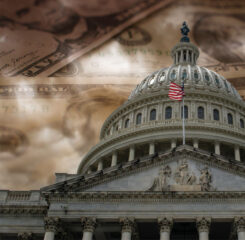CDC issues federal eviction moratorium through end of year
On September 1st, the Centers for Disease Control and Prevention (CDC) announced a temporary eviction moratorium to prevent the further spread of COVID-19. Under the order, landlords and property owners are prohibited from evicting certain tenants impacted by COVID-19, or face high monetary fines.
Titled the “Temporary Halt in Residential Evictions to Prevent the Further Spread of COVID-19,” the moratorium applies only to non-payment of rent, and will not apply to residents who engage in criminal activity, threaten the health or safety of other residents, damage the property, or violate their lease, other than for rent nonpayment. The Order does not forgive rent or prohibit landlords or property owners from charging late fees.
The Order also does not apply in any state or local area that already has a moratorium on residential evictions; according to a White House call on the new eviction moratorium, approximately 30 states and localities have residential eviction protections currently in place due to COVID-19.
The Agency Order, which applies to tenants under a certain income threshold who are at risk of becoming homeless if evicted, is effective immediately after publication on September 4th, and will be in effect through December 31st, 2020. The emergency action can be extended, modified, or extended before the end of the year.
Who is Protected by the new Eviction Moratorium?
The new Agency-ordered eviction moratorium is broader in scope than the previous moratorium under the CARES Act. Eligible renters include those who qualified for a stimulus check under the CARES Act based on their annual income, and those who would become homeless if evicted. In order to certify applicability, a renter can submit a signed statement to their landlord or property owner; the statement is included as an attachment in the Agency Order and is available here.
In order to qualify for the eviction protection, the tenant will need to sign a sworn statement, provided by the Agency Order, certifying the following qualifications:
- The tenant has used their best efforts to obtain available government assistance for rent or housing;
- The tenant was eligible to receive an Economic Impact Payment (stimulus check) under the CARES Act, or has an annual of no more than $99,000 for an individual, or $198,000 for a family
- The tenant is not able to pay the full rent due to substantial loss of income, wages, or hours, or because of extraordinary out-of-pocket medical expenses (unreimbursed medical expenses exceeding 7.5% of AGI for the year)
- The tenant is using their best efforts to make partial rent payments
- The tenant has no other available housing options and if evicted, would need to move into a new residence shared by other people who live in close quarters, or would have to move into a homeless shelter
The tenant statement also says that the tenant understands that they will still have to pay rent and fees, and comply with their lease. The unpaid rent may be required by the housing provider in full once the temporary eviction moratorium expires on December 31, 2020.
Executive Order on Housing Stability: Determining the Need for Eviction Protections
The CDC order comes in response to the President’s recent Executive Order on housing stability, which tasked the CDC with determining whether halting evictions would help slow the spread of COVID-19. Under federal law, the Director of the CDC can take measures to prevent the spread of communicable diseases, in the event that local controls have been inadequate.
The order states that “housing stability helps protect public health because homelessness increases the likelihood of individuals moving into close quarters in congregate settings, such as homeless shelters, which then puts individuals at higher risk to COVID-19.”
The order cites increases in both sheltered and unsheltered homelessness as a threat in the context of the current pandemic, and determines that measures by states or localities have not all been sufficient to prevent the spread of COVID-19.
“In the absence of State and local protections, as many as 30-40 million people in America could be at risk of eviction,” says the order of the CARES Act moratorium expiration. “A wave of evictions on that scale would be unprecedented in modern times.”
LeadingAge Request for Quick Action on Evictions
Following the President’s Executive Order, LeadingAge sent a letter to the CDC and other federal agencies requesting quick action on evictions protections. The previous eviction moratorium, authorized by the CARES Act on March 27th, expired toward the end of January, leaving many households vulnerable to evictions.
“Both residents and providers of affordable housing are under severe financial strain during the ongoing health crisis, and we need protections and financial support to avoid a nationwide housing crisis,” reads the LeadingAge letter.
LeadingAge also issued a statement in collaboration with several other major housing organizations, titled “Out of Time: Congress and the Administration Must Act Now to Prevent Widespread Evictions.”
The statement reads: “During a national health emergency, when the safest thing to do is shelter at home, our country needs more housing stability, not less. We urge Congress and the Administration to … implement a national eviction moratorium for nonpayment of rent, provide emergency rental assistance to help struggling households with back and future rent, and provide financial support for all affordable housing providers to remain solvent throughout the crisis.”
The new Agency Order does not provide additional support to housing providers; LeadingAge will continue to work with HUD, other federal agencies, and lawmakers in Congress to secure financial support for housing providers throughout the pandemic.

Most Recommended
October 15, 2025
 Shutdown Week Three: Impact of Ongoing Closure on Affordable Housing
Shutdown Week Three: Impact of Ongoing Closure on Affordable Housing
December 10, 2025
Fiscal Year (FY) Funding 2026
October 07, 2025
Immigrant Workforce Matching Program Brings Workforce Relief
Recently Added
December 11, 2025
 Analysis: CY2026 Home Health Final Rule
Analysis: CY2026 Home Health Final Rule
December 09, 2025
Collaborating Around the Globe to Teach and Learn
December 08, 2025



